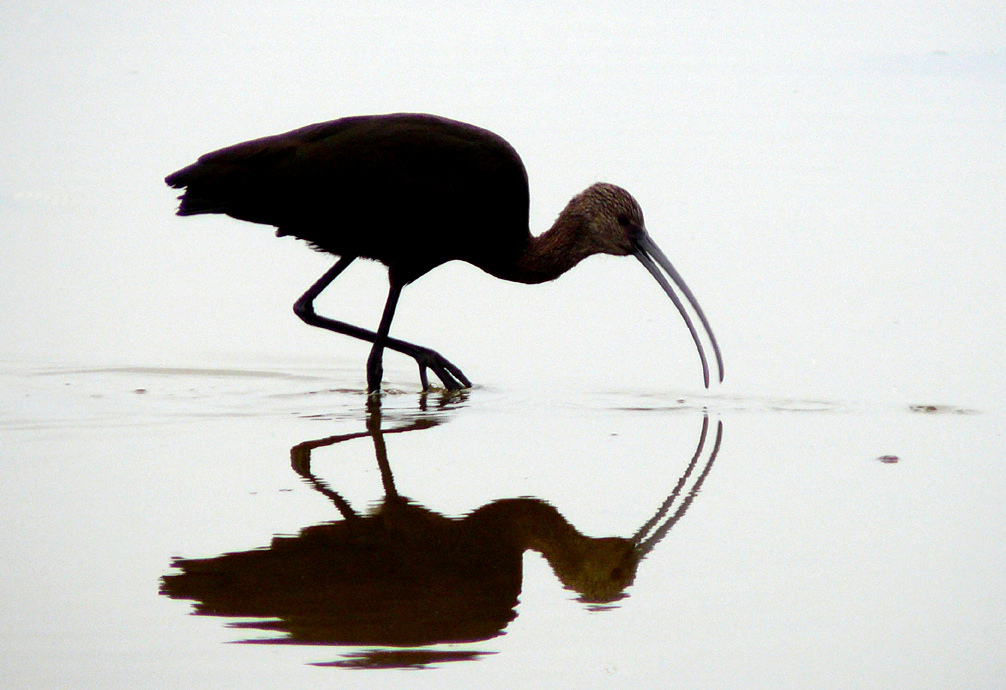An unusual bird was spotted in two separate Southeast towns on the same day last week. The ibises were a rare treat that has left bird experts scratching their heads, wondering why these southern birds have landed in Alaska.

Words like ‘flabbergasted’ and ‘astonishing’ came up when birders described hearing about the Ibis sightings last week. The large long-legged, wading bird is not native to Alaska. According to bird experts its northernmost boundary is the southern Canadian border. There has never been a recorded sighting in Alaska before now.
Andy Piston is a biologist with the Alaska Department of Fish and Game in Ketchikan. And while his professional focus is fish, he’s been studying birds in Southeast for two decades. He says if you saw an ibis you’d know it.
“You’d definitely notice,” he says. “It’s distinctive. It’s a heron-sized bird with a big, long, down-curved bill, and in the right light their plumage can look glossy and iridescent.”
The first glimpses happened last Thursday – one in Haines and one in Klawock, on Prince of Wales Island.
Bird enthusiast Jason Colon snapped a photo and posted a description of the encounter online. He wrote that he saw it in the early evening feeding in a grassy mudflat. He said its body shape and long, curved beak were dead giveaways that it was an ibis. After a little research, he deduced that it was a white-faced ibis.
Colon’s friend Amy Courtney runs Icy Straight Birding Tours out of Hoonah. She says when he sent her a photo of the bird, she knew what it was right away.
“It was definitely an ibis and I was really flipping out inside,” she says. “I didn’t realize that it would be the first Alaska record, but I knew it was going to be really rare.”
Biologist Piston says the overlapping sightings are indeed the first recorded in the state.
“I guess the bottom line is trying to say what caused it is pretty difficult. People want to say it’s related to the warm winter and spring, but it could be something unrelated down south that just caused more ibis to be in the Pacific Northwest, and a couple to stray up here.”
Haines bird expert Pam Randles says an ibis was also spotted on Friday and again on Sunday in Haines. She says she’s been fielding calls from interested parties across the state that want to come to Haines to see it. But, alas, it hasn’t been spotted since Sunday.
Randles says big changes have been happening in the bird community over the last five years or so, and “vagrants” and oddities are becoming more common. Longtime Juneau birder Gus Van Vliet agrees that perhaps something is “afoot” with the species, but he says it might also be that more people are paying attention to feathered friends around them.
“It’s hard to know whether the pace has picked up over the last five, 10, 15 years, or whether there’s just more observers, more birders, more interested people and just more coverage,” he says. “It’s sort of like rod hours when fishing for salmon – the more hours you spend, the higher the probability of catching something. That might be the case for these vagrants as well.”
Van Vliet says there are two main kinds of ibises in North America; the glossy ibis in the east and the white-faced ibis in the west.
“This could be a one-off event never to be duplicated for the next century, or it could be shades of things to come.”
According to the Audubon Field Guide, they breed mostly in California, Nevada and Southern Oregon, and dabble in the Midwest. It says they are “climate endangered” and that their northern most range is indeed along the Canadian border. There have been recorded sightings in British Columbia, though not many.
One account posted on the Haines Birders Facebook page says a group of three ibises was seen at Picture Point last week. But whether these birds will stick around, or even be seen again, is anybody’s guess.




